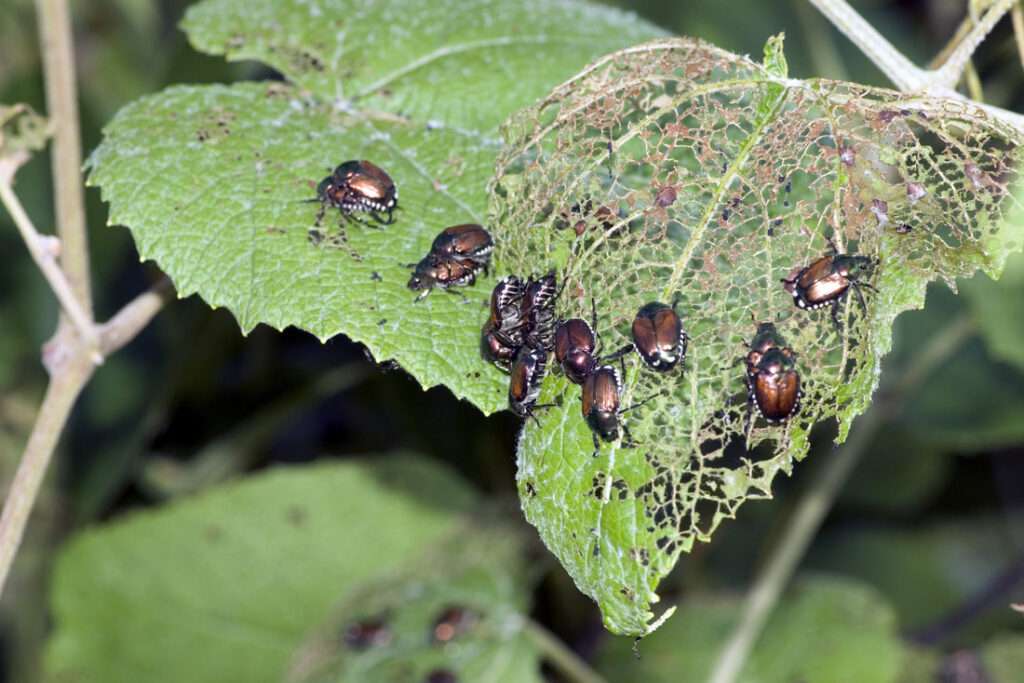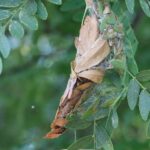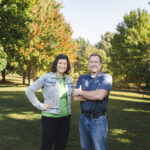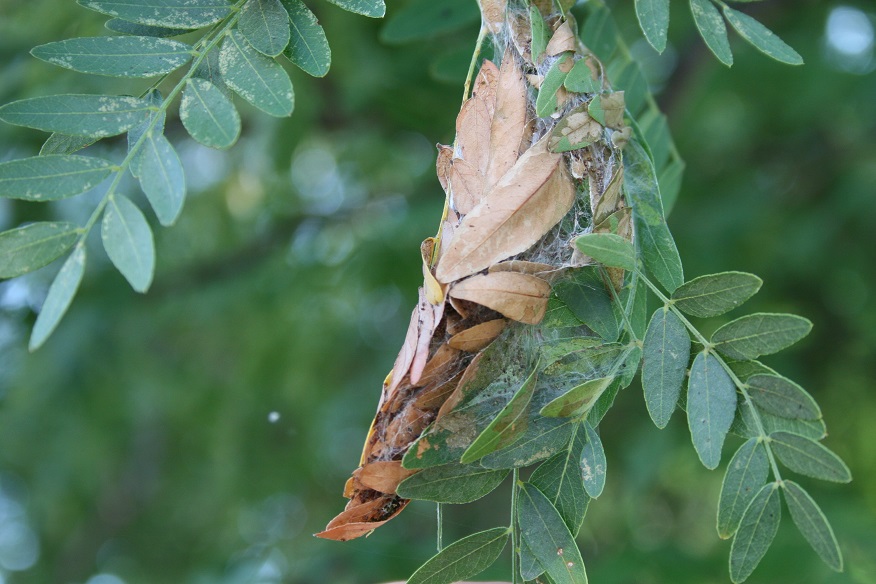Japanese Beetles in Omaha: Origins and Host Plants
The Japanese beetle is a relatively new pest in Omaha, though it has been established in the United States since the 1920s.. This iridescent copper-and-green beetle feeds on more than 200 species of plants and trees. In Nebraska, Japanese beetles are most commonly found on lindens, birches, elms, fruiting trees, roses, and buckthorn.
While feeding rarely kills mature trees outright (unless they are young or already stressed), the damage caused by Japanese beetles is a significant aesthetic concern. Repeated years of heavy feeding can deplete a plant’s energy reserves, increasing the likelihood of long-term decline.

Life Cycle and Seasonal Activity of Japanese Beetles
Japanese beetles spend the majority of their lives as grubs in the soil. As adults, they typically emerge in late June to early July and begin feeding at the tops of trees. Early feeders then release pheromones that attract additional beetles, often leading to large congregations.
As feeding progresses, damage gradually moves downward through the canopy. Consequently, leaves become “skeletonized,” with only veins remaining. Affected foliage often drops prematurely, giving trees a fall-like appearance in mid-summer.
Meanwhile, when not feeding, adults mate and lay eggs near the soil surface. Shortly thereafter, newly hatched larvae tunnel deeper into the soil in late summer, overwinter there, and resume activity the following season. In contrast to the adults, larvae feed on turfgrass roots, which can result in brown patches of lawn that pull up easily. As a result, wildlife such as skunks, raccoons, and opossums may further damage lawns while foraging for grubs.

Control Options and Prevention for Japanese Beetles
Fortunately, Japanese beetle damage can be effectively managed with an integrated approach.
Lawn (Grub) Control
If grubs have previously damaged your lawn, applying a granular insecticide in early spring can help reduce populations. In many cases, professional lawn care programs already include this treatment. However, reducing grubs alone will not prevent adult beetles from flying in from nearby properties.
Tree and Shrub Treatments
To most effectively protect trees affected by japanese beetles, apply systemic insecticides to the soil before feeding begins. As roots absorb these products, they move into the leaf tissue, where they kill beetles as they feed. However, these treatments do not repel insects—the beetle must ingest treated foliage to be affected.
Because treatment timing and product selection vary by plant type, application methods should follow species-specific guidelines:
For non-flowering trees and shrubs such as birch, elm, and buckthorn, apply imidacloprid once per year in spring, at least one month before beetle emergence.
In contrast, avoid using imidacloprid on flowering trees and fruit trees, including lindens, due to pollinator concerns. Instead, apply acephate to the soil at the onset of beetle emergence to provide approximately 4–6 weeks of control.
Finally, when systemic products act too slowly, use foliar sprays containing bifenthrin or permethrin. These sprays provide about two weeks of protection and require reapplication through mid- to late August.
Pheromone Traps: Do They Work?
A frequent question is whether pheromone traps are effective. The answer is no. Research shows these traps attract more beetles than they capture, often drawing insects in from a wider area and increasing damage to nearby plants.
Arbor Aesthetics provides professional treatment options tailored to your trees, shrubs, and landscape conditions.
References
International Society of Arboriculture. (2023). Best Management Practices: Integrated Pest Management (IPM).
https://wwv.isa-arbor.com/store/product/163/International Society of Arboriculture. (2022). Best Management Practices: Tree Protection.
https://wwv.isa-arbor.com/store/product/165/Potter, D. A., & Held, D. W. (2002). Biology and management of the Japanese beetle. Annual Review of Entomology, 47, 175–205.
https://www.annualreviews.org/doi/10.1146/annurev.ento.47.091201.145153
(Frequently referenced foundational research supporting ISA IPM strategies.)University of Nebraska–Lincoln Extension. (2023). Japanese beetle: Identification and management.
https://lancaster.unl.edu/pest/japanesebeetleUniversity of Minnesota Extension. (2022). Japanese beetle on trees, shrubs, and flowers.
https://extension.umn.edu/yard-and-garden-insects/japanese-beetlesMichigan State University Extension. (2019). Managing Japanese beetles in the landscape.
https://www.canr.msu.edu/resources/japanese-beetlesUniversity of Kentucky Entomology. (2021). Japanese beetle traps: Do they work? Entfact-451.
https://entomology.ca.uky.edu/ef451USDA Animal and Plant Health Inspection Service (APHIS). (2020). Japanese beetle program manual.
https://www.aphis.usda.gov/plant-pests-diseases/japanese-beetleU.S. Environmental Protection Agency. (2022). Pollinator protection and pesticide stewardship.
https://www.epa.gov/pollinator-protection
(Referenced by ISA BMPs when discussing neonicotinoid restrictions and flowering trees.)Cloyd, R. A. (2011). Pesticide use and pollinator impacts in ornamental landscapes. HortTechnology, 21(5), 611–615.
https://journals.ashs.org/horttech/view/journals/horttech/21/5/article-p611.xml






